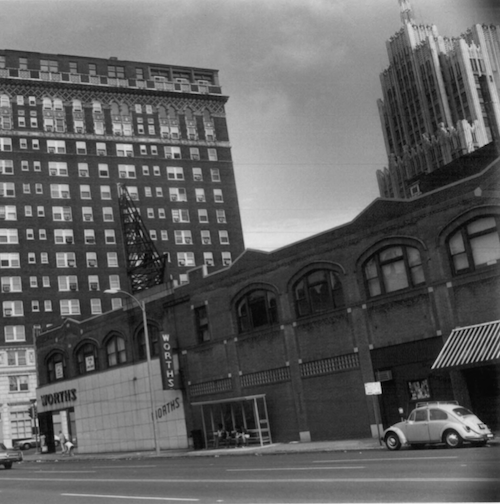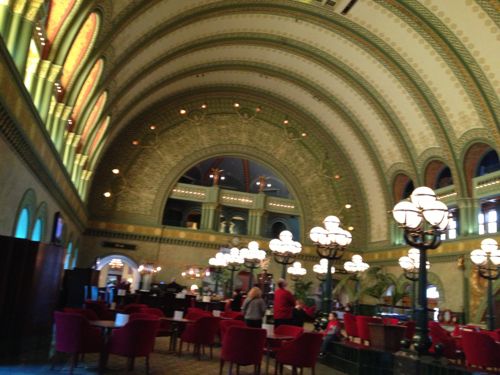Our life experiences shape our decisions and outlook on life. My parents, born in 1929 & 1931, were raised poor on the fringes of the worst part of the Dust Bowl in western Oklahoma. Their upbringing, by fathers born in the late 19th century, and moms from the early 20th century, was radically different than my childhood in a 1960s suburban subdivision.
 A couple born in the same years as my parents, but raised affluent in Ladue, are still going to have shared characteristics with my poor rural folks just as I will with their child born the year I was, even if s/he has a trust fund. Because of these shared characteristics demographers make generalizations of each generation based on the study of millions over time. Do these generalizations fit every individual from a given generation? Of course not, they are summations of tens of millions.
A couple born in the same years as my parents, but raised affluent in Ladue, are still going to have shared characteristics with my poor rural folks just as I will with their child born the year I was, even if s/he has a trust fund. Because of these shared characteristics demographers make generalizations of each generation based on the study of millions over time. Do these generalizations fit every individual from a given generation? Of course not, they are summations of tens of millions.
Wikipedia has a good summary of the seven most recent generations:
- The Lost Generation, also known as the Generation of 1914 in Europe, is a term originating with Gertrude Stein to describe those who fought in World War I. The members of the lost generation were typically born between 1883 and 1900.
- The Greatest Generation, also known as the G.I. Generation, is the generation that includes the veterans who fought in World War II. They were born from around 1901 through 1924, coming of age during the Great Depression. Journalist Tom Brokaw dubbed this the Greatest Generation in a book of the same name.
- The Silent Generation, also known as the “Lucky Few” were born 1925 through 1945, is the generation that includes those who were too young to join the service during World War II. It includes most of those who fought during the Korean War. Many had fathers who served in World War I. Generally recognized as the children of the Great Depression, this event during their formative years had a profound impact on them.
- The Baby Boomers are the generation that was born following World War II, generally from 1946 up to 1964, a time that was marked by an increase in birth rates. The term “baby boomer” is sometimes used in a cultural context. Therefore, it is impossible to achieve broad consensus of a precise date definition. The baby boom has been described variously as a “shockwave” and as “the pig in the python.” In general, baby boomers are associated with a rejection or redefinition of traditional values; however, many commentators have disputed the extent of that rejection, noting the widespread continuity of values with older and younger generations. In Europe and North America boomers are widely associated with privilege, as many grew up in a time of affluence. One of the features of Boomers was that they tended to think of themselves as a special generation, very different from those that had come before them. In the 1960s, as the relatively large numbers of young people became teenagers and young adults, they, and those around them, created a very specific rhetoric around their cohort, and the change they were bringing about.
- Generation X is generally defined as those born after the baby boom ended. Demographers, historians and commentators use beginning birth dates from the early 1960s to the early 1980s The term has also been used in different times and places for a number of different subcultures or countercultures since the 1950s.
- Generation Y, also called Millennials, describes the generation following Generation X. There are no precise dates for when the Millennial generation starts and ends. Commentators have used birth dates ranging somewhere from the latter 1970s or from the early 1980s to the early 2000s (decade).
- Generation Z is a name used (although other terms exist) for the cohort of people born from the early 2000s to the present day who are distinct from the preceding Millennial Generation. (Wikipedia)
Why bother, do the differences matter? Yes, yes they do matter. St. Louis’ first planner was Harland Bartholomew, born in 1889, was part of the Lost Generation where many died in WWI:
Those who came home were profoundly affected by their war experience. Feeling cynical about humanity’s prospects, they rebelled against the values of their elders, seeking debauchery instead of decency, and hedonism instead of ideology. (source)
It was this generation that sought to improve upon cities through massive urban renewal projects and expansive highways though Bartholomew’s New York contemporary Robert Moses (b18888) and President Dwight D. Eisenhauer (b1890), respectively.
Bartholomew, blinded by his views, missed generational change taking place during his tenure. Despite a drop in population from 1930-1940, the City Plan from 1947 said:
The Plan Commission confidently predicts that by 1970 barely a generation hence-the city proper can have 900,000 population. This would be an increase of only slightly more than 10 per cent since the 1940 census, but such a growth of 84,000 calls for making proper room for the new roofs, adequate traffic ways for the added automobiles, economical plans for all the additional public and semi-public facilities to be required. Furthermore, there must be a catching-up with all the improvements perforce neglected during the long war period. (Comprehensive City Plan 1947)
Bartholomew didn’t see that the middle class of the two generation after his, the Greatest Generation & Silent Generation, were leaving the urban core for the new suburbs. Or he thought that they’d return/stay if we just rebuilt the urban core to emulate suburban development. He was wrong, his generation was in charge at all levels of local, state and federal government.
Just as not all agree on the years for defining a generation, there isn’t agreement on how many people of each generation are with us today.
The Millennial generation, also known as Generation Y or the “Echo Boomers,” is three times bigger than Generation X and even bigger than the Baby Boom generation. The dates of the Millennial generation are not precisely defined, but depending on what measure you use, their birth dates typically stretch from the late 1980 to 2000. (source)
Other sources indicate about 50 million Gen X and 75-80 million Gen Y. What’s not disputed is Gen Y outnumbers the Baby Boomers and both outnumber Gen X.
We’re familiar with talk about how Vietnam permanently shaped the baby boomers. But if you grew up in or near an American city in the 1970s, you grew up with crime (and divorce), and this disorder was bound to leave a permanent mark. It was bound to shape the people, now in their 40s and early-50s, reaching the pinnacles of power.
It has clearly influenced parenting. The people who grew up afraid to go in parks at night now supervise their own children with fanatical attention, even though crime rates have plummeted. It’s as if they’re responding to the sense of menace they felt while young, not the actual conditions of today.
The crime wave killed off the hippie movement. The hippies celebrated disorder, mayhem and the whole Dionysian personal agenda. By the 1970s, the menacing results of that agenda were all around. The crime wave made it hard to think that social problems would be solved strictly by changing the material circumstances. Shiny new public housing blocks replaced rancid old tenements, but in some cases the disorder actually got worse. (NYTimes – Children of the ’70s)
Gen X moved to the suburbs in droves either as kids or young adults. In my case, my parents built a new suburban house while my mom was carrying me. Gen Y largely grew up in suburbia.
One area where generations vary is employment:
Relative to older generations, Gen Y is the most optimistic about the future and is willing to do whatever it takes to build a career, including going back to school, starting a business or moving back in with their parents. Despite a tough jobs market and the strong likelihood that they have student loan debt, 88 percent of millennial job seekers say they are optimistic about finding a new job. After all, they do have their whole working lives ahead of them. The fact that, overall, members of Gen Y are finding work faster than older generations surveyed may also have something to do with their optimism. The jobs millennials are getting may not be ideal — lots in retail and categories that don’t require a college degree — but at least the job hunt isn’t being dragged out forever.
Nearly half of Gen Y has considered going back to school instead of continuing their job search (35% of Gen X and 23% of Boomers), and nearly one-third are being forced to move back in with their parents (31% of Gen Y, 24% of Gen X and 13% of Boomers). One more difference about millennials is that, naturally enough for a generation that came of age with Twitter and Facebook, they’re more likely to use social media in the course of the job hunt. Before interviewing, Gen Y members are more likely to follow and interact with the company’s social media profiles over older generations (24% of Gen Y, vs. 19% of Gen X and 16% of Boomers). (Time.com – How Different Generations of Americans Try to Find Work)
Once hired, Gen Y are very different in the workplace than older workers:
Right now, there are about 80 million millennials and 76 million boomers in America. Half of all millennials are already in the workforce, and millions are added every year. Approximately 10,000 millennials turn 21 every day in America, and by the year 2025, three out of every four workers globally will be Gen Y. “This generation is reshaping today’s consumer and media markets, and even MTV itself,” says Nick Shore, a senior vice president at MTV involved in the “No Collar Workers” study.
Gen Y will also reshape the workplace—sooner than later, if they have their way. Among other characteristics that stand out, millennials, who have come of age with the text message and social media, are an impatient bunch: They’re hyper-connected, tech savvy, entrepreneurial, and collaborative. They also favor fast-paced work environments, want quick promotions, and aren’t fans of traditional office rules and hierarchies. (Time.com – Millennials vs. Baby Boomers: Who Would You Rather Hire?)
Where Gen Y works is different too:
Gen Y workers don’t tend to have jobs inside the biggest U.S. companies, especially if those companies are not in high tech. Most members of Gen Y prefer to work for smaller firms that offer more flexibility and the chance to do social networking at work without strict corporate guidelines. The survey showed that the highest concentration of Gen Y workers, 47%, work for companies with fewer than 100 employees, followed by medium-sized companies with between 100 and 1,500 employees (30%). The fewest, 23%, work in companies with more than 1,500 employees. Of those companies, the top five are all tech firms: Qualcomm, Google, Medtronic, Intel and Microsoft. (Forbes – The Best Cities For Gen Y Jobs)
Considerable attention was paid to housing as Boomers sought suburban housing when they were raising families. Now developers are focusing on housing Gen Y.
Given their large numbers and potential to consume, Generation Y, most of whom are in their 20s and early 30s, are a major focus of real estate investors and developers. Prominent researchers have investigated and analyzed how this generation will consume, live, work and play.
The quote above is from the description of an upcoming ULI (Urban Land Institute) St. Louis event: Generation Y: What Kind of Real Estate Do They Really Want?
Any city or metropolitan region that cannot provide affordable, walkable, and attractive neighborhoods in which gen-Yers can afford to live will simply lose the best of them to those regions that have such neighborhoods. If they have to “drive ’til they qualify,” as the workforce before them has had to do, gen-Yers are more likely to simply fly off to another city or region.
Simply put, generation Y represents the future of every region’s economy. Attracting and keeping this group requires careful planning and a commitment to develop new mixed-income housing in mixed-use neighborhoods close to the central city and to the surrounding suburban town centers. The time to do this is now, while gen-Yers are still living at home, because when jobs for them do come back, the pent-up demand they represent will move quickly to those regions that are ready for them. (ULI – Housing Gen Y: The Next Challenge for Cities)
Boomers and Gen X did the “drive until you qualify” routine to find affordable new housing. Thankfully Gen Y isn’t interested in driving out from the core to reach affordable housing. In fact, they’re not too interested in driving in general.
From 2001 to 2009, the average annual number of vehicle-miles traveled by people ages 16-34 dropped 23 percent, from 10,300 to 7,900, the survey found. Gen Y-ers, also known as Millennials, tend to ride bicycles, take public transit and rely on virtual media.
More than a quarter of Millennials – 26 percent – lacked a driver’s license in 2010, up 5 percentage points from 2000, the Federal Highway Administration reported. (Reuters – America’s Generation Y not driven to drive)
Cynical Boomers will say this is simply because they’re unemployed or underemployed in large numbers. “Get them jobs and they’ll be driving like we have” is the viewpoint. This is how older generations misunderstand later generations, failing to see emerging trends early on. In February 2008, pre-recession, a NY Times piece
In the last decade, the proportion of 16-year-olds nationwide who hold driver’s licenses has dropped from nearly half to less than one-third, according to statistics from the Federal Highway Administration.
Reasons vary, including tighter state laws governing when teenagers can drive, higher insurance costs and a shift from school-run driver education to expensive private driving academies.
To that mix, experts also add parents who are willing to chauffeur their children to activities, and pastimes like surfing the Web that keep them indoors and glued to computers. (NY Times – Fewer Youths Jump Behind the Wheel at 16)
Certainly lack of work is part of the reason but so is the fact Gen Y grew up being driven everywhere by their parents.
The cities/regions that understand Gen Y will be able to attract them and the employers that want to hire them. Some of these employers will be run by members of Gen Y. The sheer numbers entering the workforce, moving out of mom & dad’s safe suburban home, and willingness to relocate means a migration is on. Will the St. Louis region capitalize on this by making the entire core (ie: city) the type of walkable place they seek? Right now I’d say no, we won’t capitalize on the chance to retain and attract significant numbers of Gen Y.
– Steve Patterson




 A couple born in the same years as my parents, but raised affluent in Ladue, are still going to have shared characteristics with my poor rural folks just as I will with their child born the year I was, even if s/he has a trust fund. Because of these shared characteristics demographers make generalizations of each generation based on the study of millions over time. Do these generalizations fit every individual from a given generation? Of course not, they are summations of tens of millions.
A couple born in the same years as my parents, but raised affluent in Ladue, are still going to have shared characteristics with my poor rural folks just as I will with their child born the year I was, even if s/he has a trust fund. Because of these shared characteristics demographers make generalizations of each generation based on the study of millions over time. Do these generalizations fit every individual from a given generation? Of course not, they are summations of tens of millions.




